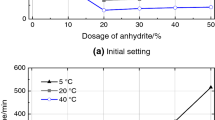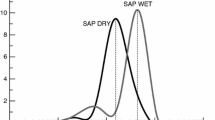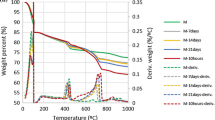Abstract
In this study, calcium sulfoaluminate (CSA) cement pastes were tested for heat of hydration and chemical shrinkage at temperatures of 20 °C, 30 °C and 40 °C. Apparent activation energy (\(E_{a}\)) values were then calculated using both exponential and hyperbolic methods. The average \(E_{a}\) of the CSA cements ranged from 42.24 to 80.22 kJ/mol, much higher than that of Type I Portland cement (38–45 kJ/mol). \({E}_{a}\) increased slightly with the replacement of silica fume for cement. However, average \({E}_{a}\) decreased by 18.4% when 20% Class C fly ash was used, but increased by 21.3% when 40% Class C fly ash was used. \(E_{a}\) calculated from heat of hydration using the exponential method is 17% lower than that obtained using the hyperbolic method. When the exponential method was used, \({E}_{a}\) values determined using heat of hydration were 30% higher than those obtained using chemical shrinkage.










Similar content being viewed by others
References
Thomas RJ, Maguire M, Sorensen AD, Quezada I (2018) Calcium sulfoaluminate cement: benefits and applications. Concr Int 40:65–69
Niu M, Li G, Wang Y et al (2019) Immobilization of Pb2+ and Cr3+ using bentonite-sulfoaluminate cement composites. Constr Build Mater 225:868–878. https://doi.org/10.1016/j.conbuildmat.2019.06.184
Tang S, Zhu H, Li Z et al (2015) Hydration stage identification and phase transformation of calcium sulfoaluminate cement at early age. Constr Build Mater 75:11–18. https://doi.org/10.1016/j.conbuildmat.2014.11.006
Yang X, Sun Z, Yang H et al (2017) Identification of hydration stage of calcium sulfoaluminate cement at an early age with helium pycnometry. Mater Struct 50:1–13. https://doi.org/10.1617/s11527-017-1050-6
Liao Y, Wei X, Li G (2011) Early hydration of calcium sulfoaluminate cement through electrical resistivity measurement and microstructure investigations. Constr Build Mater 25:1572–1579. https://doi.org/10.1016/j.conbuildmat.2010.09.042
Saadoon T, Gómez-Meijide B, Garcia A (2019) New predictive methodology for the apparent activation energy and strength of conventional and rapid hardening concretes. Cem Concr Res 115:264–273. https://doi.org/10.1016/j.cemconres.2018.10.020
Atkins P, de Paula J (2009) Elements of Physical Chemistry, 5th edn. Oxford University Press, NewYork
Kada-Benameur H, Wirquin E, Duthoit B (2000) Determination of apparent activation energy of concrete by isothermal calorimetry. Cem Concr Res 30:301–305. https://doi.org/10.1016/S0008-8846(99)00250-1
Pang X, Bentz DP, Meyer C et al (2013) A comparison study of Portland cement hydration kinetics as measured by chemical shrinkage and isothermal calorimetry. Cem Concr Compos 39:23–32. https://doi.org/10.1016/j.cemconcomp.2013.03.007
Xu Q, Hu J, Ruiz JM et al (2010) Isothermal calorimetry tests and modeling of cement hydration parameters. Thermochim Acta 499:91–99. https://doi.org/10.1016/j.tca.2009.11.007
Bentz DP (2014) Activation energies of high-volume fly ash ternary blends: hydration and setting. Cem Concr Compos 53:214–223. https://doi.org/10.1016/j.cemconcomp.2014.06.018
ASTM C1608 (2017) Standard test method for chemical shrinkage of hydraulic cement paste, ASTM International, West Conshohocken, PA. http://www.astm.org
Scrivener K, Ruben S, Lothenbach B (2016) A Practical guide to microstructural analysis of cementitious materials Boca Raton
Siddiqui S, Riding KA (2012) Effect of calculation methods on cement paste and mortar apparent activation energy. Adv Civ Eng Mater 1:1–19. https://doi.org/10.1520/acem20120011
Lura P, Winnefeld F, Klemm S (2010) Simultaneous measurements of heat of hydration and chemical shrinkage on hardening cement pastes. J Therm Anal Calorim 101:925–932. https://doi.org/10.1007/s10973-009-0586-2
Carino N (1984) The maturity method: Theory and application. Cem Concr Aggregates 6:61–73. https://doi.org/10.1520/cca10358j
Barnett SJ, Soutsos MN, Millard SG, Bungey JH (2006) Strength development of mortars containing ground granulated blast-furnace slag: effect of curing temperature and determination of apparent activation energies. Cem Concr Res 36:434–440. https://doi.org/10.1016/j.cemconres.2005.11.002
ASTM C1074 (2019) Standard practice for estimating concrete strength by the maturity method, ASTM International, West Conshohocken, PA. http://www.astm.org
Julio-Betancourt GA, Hooton RD (2004) Study of the joule effect on rapid chloride permeability values and evaluation of related electrical properties of concretes. Cem Concr Res 34:1007–1015. https://doi.org/10.1016/j.cemconres.2003.11.012
Wei X, Xiao L (2010) Determination of activation energy of cement hydration by electrical resistivity measurement. In: K. van Breugel; Guang Ye; Yong Yuan (ed) 2nd International Symposium on Service Life Design for Infrastructure. RILEM Publications SARL, pp 883–890
Nokken MR (2016) Electrical conductivity to determine maturity and activation energy in concretes. Mater Struct 49:2209–2221. https://doi.org/10.1617/s11527-015-0644-0
Dovál M, Palou M, Kovár V (2005) Heat evolution and mechanism of hydration in CaO-Al2O3-SO3 system. Ceram - Silikaty 49:104–108
Tao J, Wei X (2019) Effect of ground granulated blast-furnace slag on the hydration and properties of cement paste. Adv in Cem Res 31(6): 251–260. https://doi.org/10.1680/jadcr.17.00166
He Z, Yang H, Liu M (2014) Hydration mechanism of sulphoaluminate cement. J Wuhan Univ Technol - Mater Sci Ed 29:70–74. https://doi.org/10.1007/s11595-014-0869-8
Bullerjahn F, Boehm-Courjault E, Zajac M et al (2019) Hydration reactions and stages of clinker composed mainly of stoichiometric ye’elimite. Cem Concr Res 116:120–133. https://doi.org/10.1016/j.cemconres.2018.10.023
He Z, Yang H, Hu S, Liu M (2013) Hydration mechanism of silica fume-sulphoaluminate cement. J Wuhan Univ Technol - Mater Sci Ed 28:1128–1133. https://doi.org/10.1007/s11595-013-0832-0
Thomas JJ, Jennings HM, Chen JJ (2009) Influence of nucleation seeding on the hydration mechanisms of tricalcium silicate and cement. J Phys Chem C 113:4327–4334. https://doi.org/10.1021/jp809811w
Geiker M, Knudsen T (1982) Chemical shrinkage of Portland cement pastes. Cem Concr Res 12:603–610. https://doi.org/10.1016/0008-8846(82)90021-7
Zhang J, Weissinger EA, Peethamparan S, Scherer GW (2010) Early hydration and setting of oil well cement. Cem Concr Res 40:1023–1033. https://doi.org/10.1016/j.cemconres.2010.03.014
Brooks A, Schindler A, Barnes RW (2007) Maturity method evaluated for various cementitious materials. J Mater Civ Eng 19:1017–1025. https://doi.org/10.1061/(ASCE)0899-1561(2007)19:12(1017)
Kjellsen KO, Detwiler RJ, Gjorv OE (1990) Backscattered electron imaging of cement pastes hydrated at different temperatures. Cem Concr Res 20(2): 308–311. https://doi.org/10.1016/0008-8846(90)90085-C
Kjellsen KO, Detwiler RJ, Gjorv OE (1991) Development of microstructures in plain cement pastes hydrated at different temperatures. Cem Concr Res 21(1):179–189. https://doi.org/10.1016/0008-8846(91)90044-I
Lin F, Meyer C (2009) Hydration kinetics modeling of Portland cement considering the effects of curing temperature and applied pressure. Cem Concr Res 39(4):255–265. https://doi.org/10.1016/j.cemconres.2009.01.014
Jayapalan AR, Jue ML, Kurtis KE (2014) Nanoparticles and apparent activation energy of Portland cement. J Am Ceram Soc 97:1534–1542. https://doi.org/10.1111/jace.12878
Chaunsali P, Ardeshirilajimi A, Mondal P (2018) On the interaction of Class C fly ash with Portland cement–calcium sulfoaluminate cement binder. Mater Struct 51:1–9. https://doi.org/10.1617/s11527-018-1245-5
Chaunsali P, Mondal P (2016) Physico-chemical interaction between mineral admixtures and OPC-calcium sulfoaluminate (CSA) cements and its influence on early-age expansion. Cem Concr Res 80:10–20. https://doi.org/10.1016/j.cemconres.2015.11.003
Gutteridge WA, Dalziel JA (1990) Filler cement: The effect of the secondary component on the hydration of Portland cement: Part 1. A fine non-hydraulic filler. Cem Concr Res 20(5): 778–782
Gutteridge WA, Dalziel JA (1990) Filler cement: The effect of the secondary component on the hydration of portland cement: part 2: Fine hydraulic binders. Cem Concr Res 20(6):853–861. https://doi.org/10.1016/0008-8846(90)90011-L
Ioannou S, Reig L, Paine K, Quillin K (2014) Properties of a ternary calcium sulfoaluminate–calcium sulfate–fly ash cement. Cem Concr Res 56: 75–83. https://doi.org/10.1016/j.cemconres.2013.09.015
Martin LHJ, Winnefeld F, Tschopp E, Müller CJ, Lothenbach B (2017) Influence of fly ash on the hydration of calcium sulfoaluminate cement. Cem Concr Res 95:152–163. https://doi.org/10.1016/j.cemconres.2017.02.030
Acknowledgements
This work was supported by the State Key Laboratory of Refractories and Metallurgy (Wuhan University of Science and Technology) [grant number ZR201901]; the CRSRI Open Research Program [grant number CKWV2019756/KY]; the National Natural Science Foundation of China (NSFC) [grant number 51608402]; and the China Scholarship Council (CSC) [grant number 201808420105]. The first two authors would like to thank Sichun Wang for helping to revise the manuscript.
Author information
Authors and Affiliations
Corresponding author
Ethics declarations
Conflict of interest
The authors declare that they have no conflict of interest.
Additional information
Publisher's Note
Springer Nature remains neutral with regard to jurisdictional claims in published maps and institutional affiliations.
Rights and permissions
About this article
Cite this article
Liao, Y., Gui, Y., Wang, K. et al. Activation energy of calcium sulfoaluminate cement-based materials. Mater Struct 54, 162 (2021). https://doi.org/10.1617/s11527-021-01753-3
Received:
Accepted:
Published:
DOI: https://doi.org/10.1617/s11527-021-01753-3




